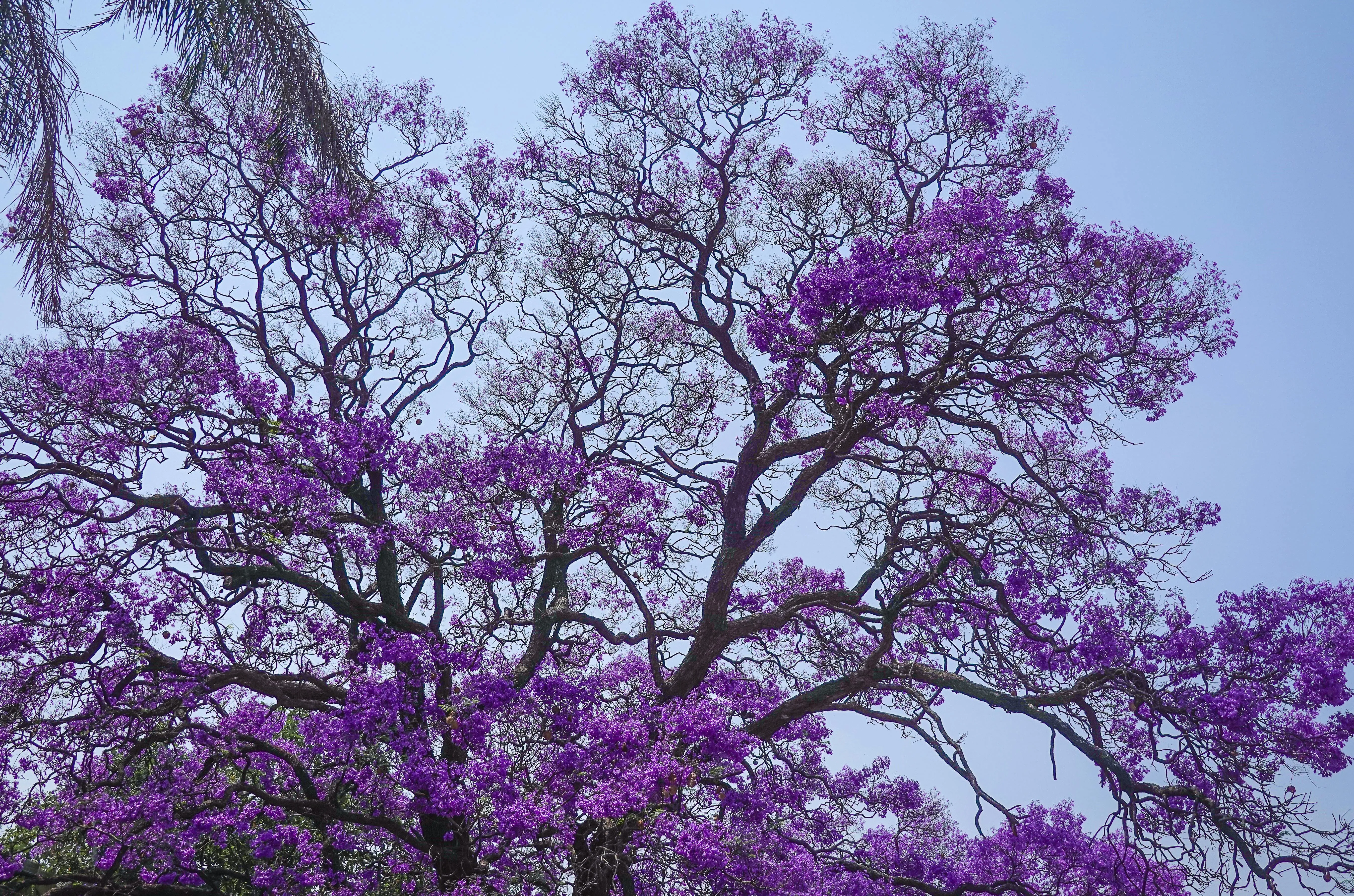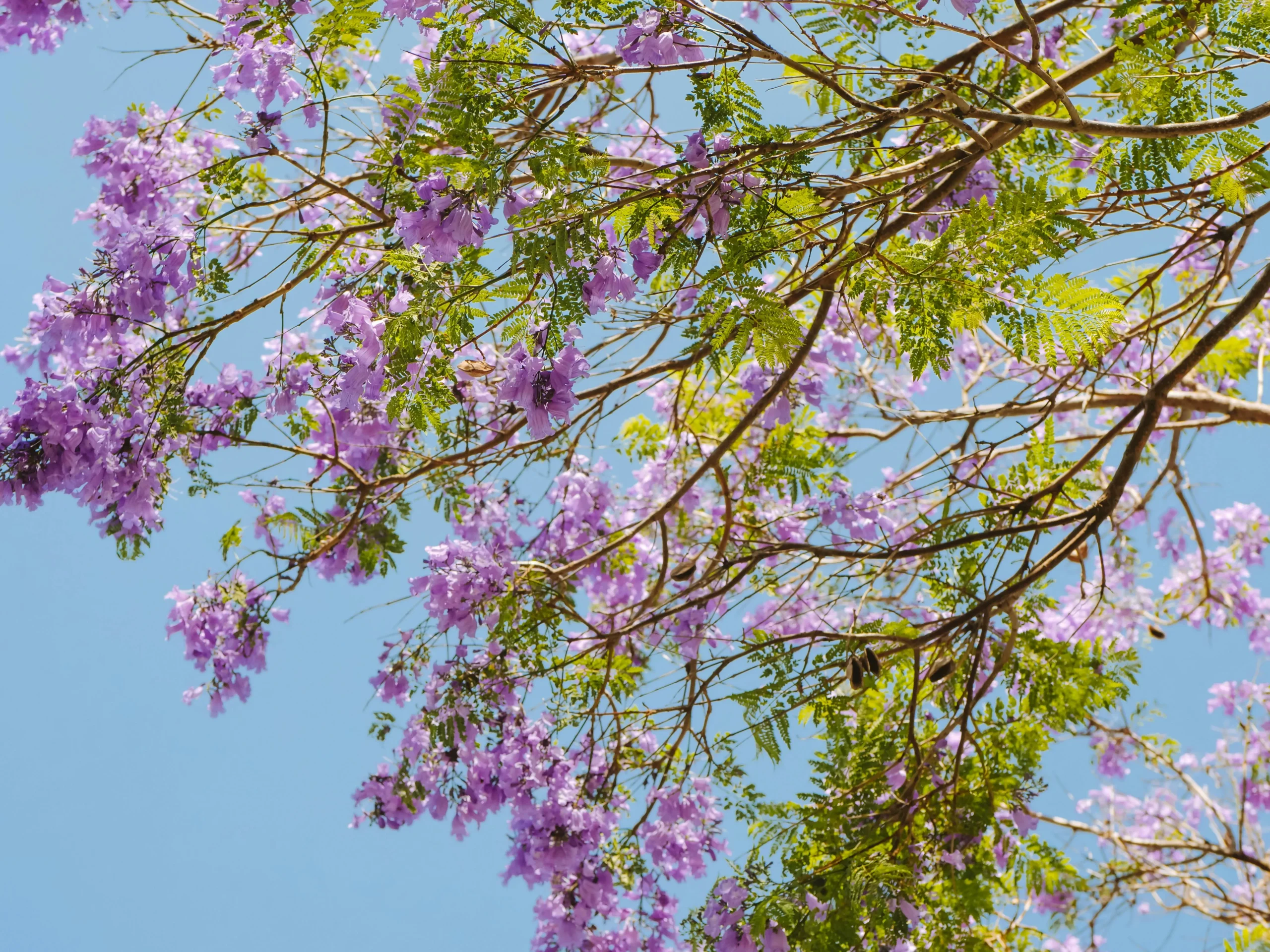Table of Contents
Every spring, Maui transforms into a dreamlike landscape of violet clouds—thanks to one of the island’s most beloved seasonal displays: the blooming of the jacaranda tree, often referred to by travelers as the purple flower tree. With its striking lavender-purple blossoms and wide, fern-like canopy, the jacaranda has become one of Maui’s most photographed trees, a natural spectacle that draws visitors back year after year.
If you’ve ever planned a trip to Maui in late spring, chances are you’ve seen photos of roads dusted in purple petals, upcountry hillsides shimmering with color, and iconic towns painted in nature’s watercolor. The jacaranda isn’t native to Hawaiʻi, yet it has become an unforgettable part of the island’s identity—especially in the Upcountry regions where the trees thrive.
In this guide, you’ll learn when and where to see this magical purple flower tree, why it blooms so vibrantly on Maui, and how to include jacaranda viewing in your travel plans.
A Brief History of the Jacaranda on Maui
The jacaranda tree (Jacaranda mimosifolia) originated in South America, particularly Argentina, Bolivia, and Brazil. Its journey to Hawaiʻi began in the early 20th century, when botanists and landscape experts began introducing colorful flowering trees to the islands. Maui’s cool Upcountry climate—unusual for Hawaiʻi—proved to be the perfect home.
Over the decades, as ranchers, farmers, and residents planted the trees around homes, streets, and open fields, they spread throughout communities like Makawao, Kula, Ulupalakua, and Pukalani. Today, Upcountry’s jacaranda bloom is a celebrated seasonal event, cherished by locals and a must-see for visitors.

Why the Jacob’s Ladder of Purple Color Thrives on Maui
Jacaranda trees flourish in warm climates with mild winters, well-drained soil, and full sunlight. While coastal areas of Maui stay too warm and humid for the strongest blooms, the elevated slopes of Haleakalā offer the perfect combination of:
- Cool nights
- Warm, sunny days
- Volcanic soil rich in nutrients
- Seasonal rainfall
These conditions trigger the dramatic, predictable bloom that sweeps through Upcountry every spring.
Thanks to the island’s microclimates, Maui’s jacaranda season is especially vibrant—often brighter and longer-lasting than in other tropical regions.
When Do the Purple Flower Trees Bloom on Maui?
The jacaranda bloom typically peaks from late April through early June, though exact timing can shift year to year based on rainfall and temperature.
Bloom Timeline (Typical Year)
- Late April: Trees begin budding; early lavender blooms pop up.
- May: Full bloom season—trees are covered in dense purple flowers.
- Early June: Blossoms begin falling, leaving purple carpets along roads.
If you’re planning a spring visit to Maui, aim for May to guarantee the best viewing.
Where to See Jacaranda Trees on Maui
While individual jacaranda trees can be found across the island, the most impressive clusters are in Upcountry Maui. These rural communities offer rolling landscapes, quiet roads, and sweeping views of the ocean—all framed by bursts of purple canopy.
Top Places to View Maui’s Purple Flower Trees
Kula
Known for its cool climate and farms, Kula is considered the jacaranda capital of Maui. The trees line the roads and pastures, creating some of the most iconic photo spots.
Makawao
This cowboy town (paniolo culture runs deep here) bursts with jacaranda during peak season. Streets become tunnel-like paths of purple bloom, especially beautiful in the early morning light.
Pukalani
Meaning “hole in the heavens,” Pukalani offers dramatic valley and ocean views enhanced by the lavender crown of jacaranda flowers.
Ulupalakua
With wide pastures and open spaces, this area showcases the jacaranda against the backdrop of Haleakalā’s slopes.

Photography Tips for Capturing the Purple Flower Tree
The jacaranda tree is a photographer’s dream, but timing and angles matter. Use these tips for the best results:
- Visit in the morning for soft, warm light.
- Shoot underneath the canopy for a glowing purple ceiling effect.
- Capture the “purple snow”—fallen petals create stunning foreground textures.
- Use a polarizing filter to deepen the sky’s blues and make the purple pop.
- Frame the tree with Maui scenery for context: ocean vistas, Haleakalā, rolling farmland.
Why Visitors Call It Maui’s Most Magical Tree
While Maui is full of colorful and exotic flora—plumeria, hibiscus, orchids—the jacaranda stands apart. It’s not just the vivid color but the scale: enormous, mature trees with expansive purple crowns. The bloom feels fleeting and rare, creating a sense of seasonal magic that visitors remember long after their trip.
For many, experiencing the jacaranda bloom becomes a core memory of Maui.
Helpful Links
- https://www.gohawaii.com/islands/maui
- https://www.mauivisit.com
- https://www.gohawaii.com/experiences/nature
Frequently Asked Questions
1. What is the purple flower tree I see all over Maui?
That’s the jacaranda tree, known for its vibrant lavender-purple blossoms that bloom primarily in Upcountry Maui.
2. When is the best month to see the jacaranda trees bloom?
May is the peak month, offering the fullest, brightest bloom of the season.
3. Where should I go on Maui to see the most jacaranda trees?
Head to Makawao, Kula, Pukalani, and Ulupalakua—these Upcountry regions offer the highest density of jacaranda.
4. Are jacaranda trees native to Maui?
No. They originated in South America but have been thriving on Maui for over a century.
5. Do the purple flower trees bloom all year?
They bloom seasonally, usually from late April to early June.
6. Why do jacaranda trees bloom more in Upcountry?
Because the cooler temperatures, sunshine, and volcanic soil on the slopes of Haleakalā create ideal conditions.
7. Can I take jacaranda photos without crowds?
Yes—visit early morning or explore less-traveled Upcountry backroads where traffic is minimal.
8. Does the jacaranda have any cultural meaning in Hawaiʻi?
While not native, it has become a beloved seasonal symbol and a cherished part of Upcountry’s landscape.
If you would like to read and learn more about interesting things in Hawaii! Check out our blog page here on our website!
or
